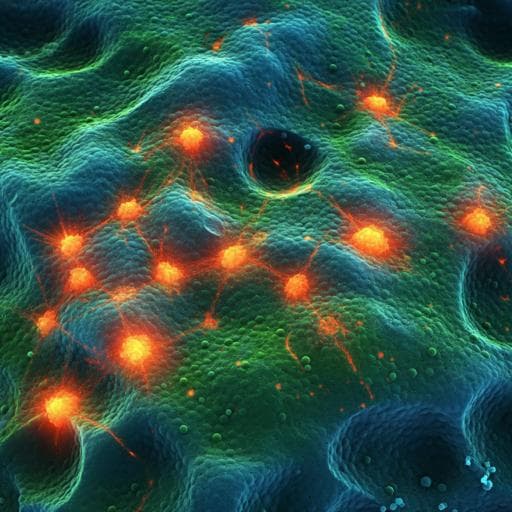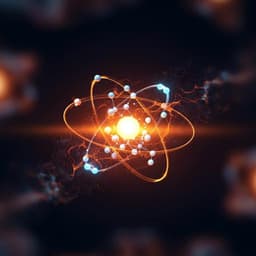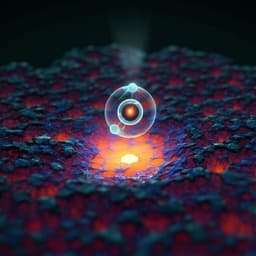
Chemistry
Rational strain engineering of single-atom ruthenium on nanoporous MoS<sub>2</sub> for highly efficient hydrogen evolution
K. Jiang, M. Luo, et al.
This groundbreaking research explores the enhancement of alkaline hydrogen evolution reaction (HER) through strain-tunable sulfur vacancies around single-atom Ru sites on nanoporous MoS2. The innovative approach amplifies the synergistic effects, achieving impressive catalytic performance. Conducted by Kang Jiang, Min Luo, Zhixiao Liu, Ming Peng, Dechao Chen, Ying-Rui Lu, Ting-Shan Chan, Frank M. F. de Groot, and Yongwen Tan.
~3 min • Beginner • English
Introduction
The study addresses how to maximize the catalytic activity of single-atom catalysts (SACs) for the hydrogen evolution reaction (HER), particularly in alkaline media where multi-step kinetics limit performance. While SACs offer high atom efficiency and well-defined sites, single sites often catalyze only one reaction step efficiently. Synergistic dual sites can improve activity, but atomically precise preparation and mechanistic elucidation are challenging. MoS2 is a cost-effective HER catalyst whose inert basal plane can be activated via phase engineering, sulfur vacancies (SVs), and single-atom doping. Single-atom doping can induce SVs, yet the synergy between SVs and single atoms under realistic conditions is not fully understood. The authors hypothesize that strain engineering can amplify the synergy between SVs and single-atom Ru on MoS2, enhancing reactant accumulation and kinetics, thereby improving alkaline HER.
Literature Review
Prior works established SACs as promising for electrocatalysis due to maximized atom utilization and unique coordination (e.g., Pt1/FeOx; single-atom Pt, Ni, Fe catalysts). For MoS2, strategies to activate the basal plane include 2H→1T phase engineering, creating sulfur vacancies, and single-atom doping (Pd, Ir, Co, etc.), which can produce active SVs and local 1T phases. Strain in 2D materials can tune electronic structures and break catalytic scaling relations, potentially optimizing adsorption energies of intermediates. Earlier studies showed strained SVs in MoS2 enhance HER and that metal-atom doping can trigger local phase transition and create SVs, but the detailed synergistic interaction between single atoms and SVs, especially under operando conditions, remained unclear. This work builds on these insights by combining strain engineering with Ru single-atom doping on nanoporous MoS2 and probing mechanisms via operando XAS and AP-XPS.
Methodology
- Theoretical calculations: Density functional theory (DFT) assessed Ru substitutional doping in MoS2, SV formation energies, water adsorption energies (ΔE_H2O), Volmer step barriers (ΔG(H2O)), and hydrogen adsorption free energies (ΔG(H*)). Effects of tensile strain on Ru and Mo sites beneath SVs (Mo_SV) were evaluated via projected density of states and energetics.
- Synthesis of supports: Three-dimensional nanoporous MoS2 (np-MoS2) with bicontinuous architecture and nanotube-shaped ligaments was synthesized by gold-assisted CVD growth of monolayer MoS2 on nanoporous gold (NPG) followed by chemical etching of NPG in I2–KI solution (12 mg I2, 6 mg KI in 100 mL DI water, 24 h) to yield free-standing np-MoS2 films.
- Single-atom Ru incorporation (spontaneous reduction): RuCl3·H2O (3 mg) was dissolved in 50 mL DI water and stirred 2 h. np-MoS2 films were immersed at room temperature for 12 h to adsorb Ru species. Films were transferred to carbon cloth, dried 12 h at room temperature and ambient pressure, then 12 h under vacuum at 60 °C to obtain Ru/np-MoS2 with isolated Ru atoms and SVs. A comparative Ru deposition via electrochemical deposition (RuCl3 in 0.5 M H2SO4; three-electrode, Ag/AgCl reference, carbon counter; 100 CV cycles from 0.0 to −0.6 V vs RHE at 50 mV s−1) was also used.
- Control supports and catalysts: Plane MoS2 (P-MoS2; negligible strain) and nanoporous MoS2 with larger ligament diameter (Lnp-MoS2; lower strain) were prepared. Ru was loaded to similar contents (Ru/P-MoS2 ~9.1 at%, Ru/Lnp-MoS2 ~8.3 at%, Ru/np-MoS2 ~8.0 at%).
- Characterization: SEM (Zeiss Sigma HD), HAADF-STEM with aberration correction (JEM-ARM 200F) with EDX mapping, XPS (Thermo ESCALAB 250Xi, Al Kα). X-ray absorption spectroscopy (XAS): Ru K- and Mo K-edges at NSRRC BL01C1; Mo L3- and S K-edges at BL16A1. EXAFS fitting and XANES analysis (ATHENA). Ambient pressure XPS (AP-XPS) at NSRRC 24A1 under UHV, 0.01 torr H2O, and 0.1 torr H2O with Au 4f calibration.
- Operando XAS: Home-built electrochemical cell; fluorescence mode at room temperature; potentials: open circuit, −0.05, −0.10 V vs RHE in Ar-saturated 1.0 M KOH. Working electrode: catalyst on carbon cloth; SCE reference; carbon rod counter.
- Electrochemistry: Three-electrode setup in Ar-saturated 1.0 M KOH at room temperature. LSV at 2 mV s−1; Tafel analysis; EIS for charge-transfer resistance; cyclic voltammetry to derive double-layer capacitance (Cdl) and ECSA for intrinsic-activity normalization; chronoamperometry for stability; gas chromatography for H2 Faradaic efficiency.
- Strain assessment: EXAFS Mo–Mo radial distance shifts used to infer bending/tensile strain associated with ligament curvature; comparison across P-MoS2, Lnp-MoS2, and np-MoS2.
Key Findings
- DFT: Ru substitution at Mo site is exothermic (formation energy −0.650 eV), indicating thermodynamically favorable substitutional doping. Ru doping lowers SV formation energy in 1T-MoS2 by 0.832 eV, enabling SV creation around Ru. Without strain, water adsorption on Ru is strong (ΔE_H2O = −0.516 eV) and Ru exhibits low Volmer barrier and near-optimal ΔG(H*), facilitating H–H coupling. Under tensile strain, Mo_SV sites show significantly enhanced water affinity (lower ΔE_H2O) through increased Mo 3d–O 2p overlap; strain increases Ru 3d DOS near Fermi level, lowering Volmer barriers and decreasing ΔG(H*) on Ru and S, predicting enhanced HER kinetics and synergy between SVs and Ru.
- Structure and electronic state: XPS Ru 3p shows ~+2.1 eV shift vs Ru nanoparticles on np-MoS2, indicating strong interaction and altered Ru charge density. Ru K-edge XANES places Ru/np-MoS2 between RuCl3 and RuO2, consistent with oxidized Ru single atoms; FT-EXAFS shows Ru–S peak (~1.60 Å) and Ru–Mo features, consistent with isolated, substitutional Ru coordinated to four S with two S vacancies. Mo K-edge XANES/EXAFS indicate increased 1T content, abundant SVs, interfacial effects, and structural disorder upon Ru doping.
- Strain quantification: FT-EXAFS Mo–Mo peak exhibits greatest high-R shift for np-MoS2 vs Lnp-MoS2 and P-MoS2, correlating with highest bending/tensile strain from smallest ligament diameter.
- HER performance: Ru/np-MoS2 shows zero onset, overpotential 30 mV at 10 mA cm−2, Tafel slope 31 mV dec−1 in 1.0 M KOH, outperforming Ru/P-MoS2, Ru/Lnp-MoS2, np-MoS2, and commercial Ru/C and Pt/C. ECSA-normalized currents confirm highest intrinsic activity for Ru/np-MoS2 and activity increases with strain magnitude. Cdl: Ru/np-MoS2 15.35 mF cm−2 vs np-MoS2 7.35 mF cm−2, indicating more accessible active sites (Ru and exposed Mo at SVs). Charge-transfer resistance is lower for Ru/np-MoS2 than np-MoS2. H2 Faradaic efficiency ~100% over tested potentials. Long-term chronoamperometry at 30 mV overpotential shows excellent stability; XANES/EXAFS after operation confirm Ru remains atomically dispersed without aggregation.
- Mechanism (operando): Ru K-edge operando XANES shows positive edge shift at open circuit (binding of H2O/OH− increases Ru oxidation state) and negative shift under cathodic bias (reduction with water dissociation). FT-EXAFS indicates Ru–O contributions under open-circuit and coordination distortion under bias. Mo K-edge: np-MoS2 shows little structural change and inert Mo sites; Ru/np-MoS2 shows increased Mo oxidation at open circuit (H2O/OH adsorption at SV-exposed Mo) and further increase under cathodic potentials. FT-EXAFS shows enhanced H2O/OH adsorption signals and shifts of Mo–S (negative) and Mo–Mo (positive), indicating O occupation of strained SVs and distorted Mo coordination. AP-XPS O 1s under UHV/0.01/0.1 torr H2O demonstrates greater water adsorption on Ru/np-MoS2 than on np-MoS2 at identical pressures, confirming enhanced reactant accumulation.
- Controls: Under similar Ru and 1T contents, Ru/np-MoS2 (most strained Ru/1T-MoS2) exhibits larger intrinsic activity gains than Ru/Lnp-MoS2, isolating strain as the key factor amplifying the Ru–SV synergy.
Discussion
The findings substantiate that engineered bending/tensile strain in nanoporous MoS2 ligaments amplifies the synergistic interaction between single-atom Ru and nearby sulfur vacancies. Strain strengthens water adsorption at Mo sites beneath SVs, enriching H2O/OH− within the inner Helmholtz plane and facilitating mass transfer to adjacent Ru sites. Concurrently, strain tunes the Ru electronic structure, increasing d-state density near the Fermi level to accelerate Volmer water dissociation and to optimize hydrogen adsorption for efficient H–H coupling. Operando XAS confirms dynamic Ru–O/S coordination and enhanced H2O/OH− binding at strained SVs, while AP-XPS corroborates superior water uptake on Ru/np-MoS2. Together with control samples, these results demonstrate that strain is a decisive lever to maximize SAC activity by coupling reactant-concentrating SVs with electronically optimized single-atom centers, thereby addressing limitations of single-step selectivity at isolated sites in multistep alkaline HER.
Conclusion
A strain-engineering strategy was developed to boost alkaline HER by amplifying the synergy between single-atom Ru and sulfur vacancies on nanoporous MoS2. The optimized Ru/np-MoS2 catalyst achieves 30 mV overpotential at 10 mA cm−2, a Tafel slope of 31 mV dec−1, near-100% Faradaic efficiency, and long-term stability, surpassing state-of-the-art MoS2-based catalysts and commercial benchmarks. DFT, operando XAS, and AP-XPS reveal that strain increases reactant (H2O/OH−) accumulation at SVs and enhances Ru-site kinetics via electronic modulation. These insights provide general design principles for SACs on transition metal dichalcogenides: tailoring assisting sites (e.g., vacancies/defects) and applying precise strain to maximize synergistic effects. Future work could explore other single atoms and host lattices, alternative strain-modulation methods, and broader reactions beyond alkaline HER to generalize this approach.
Limitations
- The mechanistic operando evidence, while strong, relies on indirect spectroscopic signatures (edge shifts and EXAFS peak changes) rather than direct visualization of intermediates at atomic resolution under electrochemical conditions.
- Bending strain is approximated as tensile strain at the atomic scale in modeling; exact local strain fields and distributions may be more complex in curved nanoporous ligaments.
- AP-XPS water adsorption studies are conducted under gas-phase conditions (UHV to 0.1 torr H2O), which differ from electrochemical environments; extrapolation to the electrolyte interface assumes similar adsorption trends.
- The study focuses on alkaline HER and a specific Ru/MoS2 system; generalization to other metals, hosts, or reaction conditions (e.g., acidic media) was not tested here.
Related Publications
Explore these studies to deepen your understanding of the subject.







